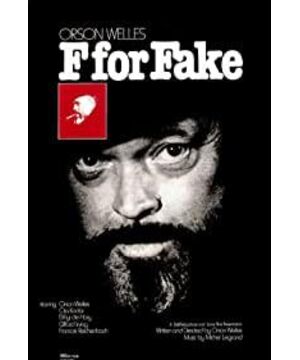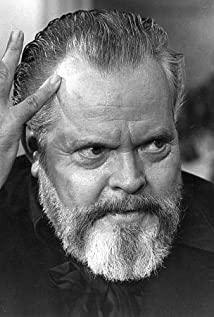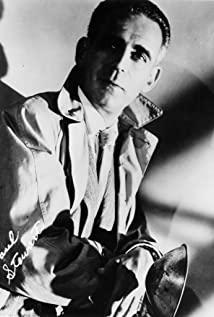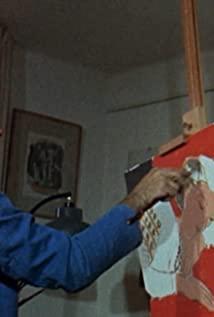The "warlock" is called Orson Welles. At this moment, he was on the train platform, deceiving the children seriously. Keys and coins were swiping away in his hands, coming at a moment's notice, in his palm for a while, and in the child's clothes pocket for a while. His thick gloved hands were amazing. His performance has both expression and expression, as if he is a true magician. The children opened their eyes wide, and they were fascinated, for fear of missing any detail, and could not see where the keys and coins were flying.
This is Orson Welles' 1976 documentary "The Fake", which is also the later work of Orson Welles' film career. The film launched an in-depth discussion on the author of fakes and fakes, which is thought-provoking. The way the film is created is different from other documentaries.
The little magic trick just now was just his improvisation, and the real "show" started immediately. I saw Wells wearing a long black trench coat and a top hat. Go to the lighted, set up set. The camera quickly moved up, and the moment Wells turned his head, there was another face, and the exaggerated face just now disappeared. He looked at the camera seriously and started talking. "Ladies and gentlemen, this is a film about deceit, trickery, and lies. On the fireside, in the fair, or almost any story in the film is some kind of lie. But not this time, no, I promise For the next hour, everything you hear from us is true, based on solid facts." He's like a TV host, telling you a story, a fact.
Orson Welles, the film wizard hailed as "a child-like giant" by the American Academy of Motion Picture Arts and Sciences. He is unassuming, full of talent, and he regards the stage as a place to play games all his life. In "Fake", he played a role in the field, providing the audience with an omniscient point of view, telling the audience about the fake, the author of the fake, etc., the details behind the scenes, and the unknown truth. Presenting a sense of authority under his well-controlled morphemes, adding trustworthiness to the audience. The set changes behind Wells, and the (rapid) push and pull of the camera set creates the effect of Wells traveling through time and space. At the same time, he is a bystander, reminding the audience that they cannot fully trust the media and must be vigilant about the information provided by the media.
Why did this film crew feel like a grass-stage team? They used human shoulders as a tripod, placed a set on the platform of the train station, and started shooting. Completely disregarding the roar of the train, the host can be as if no one else is disturbed by people coming and going.
Who is Emil?
Who are these gentlemen talking about in the gathering of artists and art dealers? Not Napoleon, Caesar, but Emile.
Who is Emil?
"He called himself Horry, Hillary, Bory, Surrey, Corey, Berry, Duri...all" Emil went by more than 60 names. It doesn't matter which name, what matters is who is this unknown person?
Emil is not a professional actor, but he is the protagonist of this film. His real name is "Emile Frank Huffman". The master of creating all kinds of painting fakes, ranked second in the list of liars. Of course, he also sells works under his real name, but only a handful. One such buyer was Clifford Owen, a biographer.
The film starts with a question, and then slowly leads the audience to find the truth. Others' comments on Emil, Emil's appearance, and interviews with Emil appear alternately. The content of the picture is trivial and messy, relying on the audience's memory to piece together the ins and outs of things. The screen changes frequently, and freeze frames are often used to emphasize the image of Emil. Behind the picture there is cheerful music, which is somewhat mocking.
Ibiza, Spain, Emir and Owen - two leading figures in the world of forgery. They weave their own "talent plans" on this poetic island.
In 1959, Emile was down and out, left the United States, wandered Europe, and finally settled on this charming island. He and Owen met nine years later. Irving's novels sold poorly at the time, and he was nearly penniless. However, Irving's talent in other areas cannot be ignored. For example, he suggested that Emil should carry out the business of counterfeiting artworks to the end and make the market for fakes bigger. Then, with the help of Emile's east wind, he also made himself popular.
These two grasshoppers on strings, touting each other and leaning against each other. What they have in common is that they are all a little smart.
Wells interviewed Emile and Owen separately, and when they edited their words together, they formed a question-and-answer effect, stating, defending, sarcasm, and praise. Wells has such ulterior motives.
Owen has his own unique understanding and macro strategy for art, including the art market. In his eyes, the quality of artwork is only the difference between a good fake and a bad fake. If there is an art collection market, there will be fakes. Because, Owen believes that the quality of the fake is the same as the original. So, what is the difference between the fake and the original? Of course he has his own conclusions. Owen talks to the camera, calm and calm.
Before Emel became famous, his whole world was a long wait to be recognized by the mainstream art market. Owen's biography for Emil helped Emil from behind and made Emil's overnight fame.
In Owen's eyes, Emile is an artist living in fantasy. Emil has made up his own life, and he can also destroy the fantasy castle he built himself.
The so-called "fantasy" is a booster to satisfy others. "Why not do it when fantasy can satisfy them?" Emil was convinced. Of course, he does not admit that he is the forger of the artwork Owen says. After all, he has been successful for 22 years. He was never rejected by the museum. The fakes born from his hands are sold all over the world. The number of fakes he created was enough to make an Impressionist museum. He simply became a national hero for some people. If these paintings hang in art galleries and museums long enough, are the things that were called fakes real?
Fortunately, Emile himself was not confused by the fakes, and he was able to soberly judge whether the painting came from his own hands. He was always confident about his skills. He knew how much time Picasso took to draw each line. He can also imitate Modigliani's creation in an hour. Since Modigliani's works are few in number, it doesn't hurt that he adds some to the famous. Matisse's lines are always hesitant, which does not match Emile's smoothness, so when he imitates, he also deliberately shakes a few times. The color is painted over and over again, which is more like an authentic Matisse.
Emil couldn't help but be overjoyed as he counted these to the audience. His words are frivolous, less strategist-like Owen's sanity, and more artist's childishness. He also challenged experts of symbolic authority to judge which work was authentic, and that it was Emile's Matisse.
Looking back on his 22-year career in counterfeiting, Emile is filled with emotion. Nor was he born with a penchant for painting fakes. Once, after his sketches were mistaken for Picasso's, he realized he could sell something, and unexpectedly made a lot of it. Relying on the operation of art dealers, he was unable to get anything out. When artists and businessmen are tied together, things often go haywire. He benefited and was deceived until he had nothing and nothing to cover. The nameless fake career made him free and easy, so what if he burned his imitations!
When Owen hyped Emil as the greatest forgery master at the time, he also rose to the sky and became a superstar. When he unabashedly revealed Emil's fake life to the world, did he take into account the Emil himself? Emil can talk and laugh in front of the camera and say that some people like him more and more after learning more details. In fact, in Emil's heart, Owen is a better magician than himself. A biography eclipses Emil, the master of forgers, by demystifying himself.
The canvas is painted with various colors and turned into a work. What is the measure of value? Michelangelo also painted forgeries, but this did not go down in history as much as it affected his reputation. What has puzzled Emil for years is why he can't be a real artist? Owen offers his unique insights, as Emile's forgery career limits his imagination. When Emil's fake career came to light, it gave him a chance to be reborn. He could give up this life of imitation altogether, give up the question of honesty, and start afresh on the imagination. Owen thought, "What a terrible thing it would be if there was no imagination on canvas."
Can readers trust Owen's words? A biography of the life of Emile, the greatest master of forgers of the time? Believe it or not, it doesn't matter for the time being; whether it's true or fictional, let's not mention it for the time being. Becoming a topic is already the first step to success. Isn't this the way that people would rather self-destruct their image and become famous by being the protagonist of the topic? Owen's way of becoming famous is to refute other people's face, in addition to using celebrities to hype himself. The second selling point of a biography is to make a fool of the self-proclaimed expert. He exposed many works that were identified as genuine by experts, as well as works that were auctioned at high prices, but they were actually fakes. He gave many examples to illustrate. This biography brought Owen to fame and fortune, and the deposit alone was as high as 250,000.
No matter how Emile and Owen challenged authority, they were tireless with the experts. But they know the trick to fakes: being recognized by experts. Authentic and fake are the same, as long as experts recognize it, it is a masterpiece. There is a very strange relationship between them and the experts, mutual flattery and mutual exclusion. Owen is an art dealer. Without their strategizing, it would be difficult for artists to enter the market. Art dealers and artists also had a love-hate relationship and calculated each other.
Although the author of the fake is suspected of disrupting the art market and driving up prices. Due to the difficulty of obtaining evidence, the law is temporarily helpless against them.
Today's Emil lives comfortably, and the painful experiences in the past make him insecure. He spoke candidly about his past. It also inspired Wells to look back on his own road to fame.
glorious history
Wells himself is not a master of counterfeiting! On October 30, 1938, he made a huge joke with Americans on CBS. He claimed on the radio that the Martians were attacking and taking over the earth. This smug line sent most of America into apocalyptic panic. For the first time, he clearly witnessed the influence of broadcasting.
The "War of the Worlds" radio drama opened up a new dimension for his career: cinema. In 1940, he directed the immortal masterpiece "Citizen Kane" in film history. It was this Wells, who knew almost nothing about photography, who created the classic long-take sequences and depth-of-field shots, who made an indelible contribution to the language of film but never won the best director award.
Wells was an avid idealist who ran for Roosevelt's re-election, giving up movies and love for it. But from his works, we can clearly feel his wakefulness. On the one hand, he accused the media of making news, and on the other hand, he also confessed to the public.
In the film, he was a starving painter. At the age of 16, she stepped onto the stage by accident. In Dublin, he was a star from New York. So he became the Emile of the radio, he didn't create a Picasso painting, he concocted the news that the Martians were coming with flying saucers.
Isn't that exactly how Wells became famous!
The sense of historical vicissitudes presented by black and white films (of course, there are also the effects of expansion films). American landmarks, people fleeing in a hurry, botched flying saucers spun down. The flying saucer kept firing, headlessly crashing into various buildings. The absurd sound effects set off the unbridled attack of the Martians and escape people's tension. The black and white images are rough, and the props are even more shoddy. With the speed of the announcer's speech on the radio, the situation became more serious and the atmosphere became more and more tense. And the radio, one of the most important props, is very delicately shot. A variety of different styles of radios appear in turn in the picture. The delicate tone and exquisite lighting are rare in the whole film. There is a strong comparison between the elegance of color and the roughness of black and white.
This history is not going to repeat itself because it took place before World War II, in the great radio era before the invention of television. The lack of images has made some philanthropists use sound to make a big fuss. But not everyone can get away with it. Later, someone in the southern United States made up similar news, and he went to prison. Luckily for Wells, "So, I shouldn't complain!" Because Wells didn't go to jail and went to Hollywood, he made a name for himself.
Using his voice to fake, Wells is probably not the first person, nor the most powerful one. There is a man named Hughes, who holds a certain economic lifeline, leaving a voice after another, never revealing the true face of Mount Lushan. On the list of liars, he recognized the second, and no one dared to recognize the first.
There are many legends about Hughes. Some people say that he bought many hotels in the casino, but no one has ever seen him. His appearance is even more confusing. He was seen walking on the road at 4am. Wells traced to the Las Vegas hotel, where there are many Hughes-named hotels, flashing neon signs that the name really exists. Wells looked at the hotel room from a distance, imagining the stories that happened here, connecting all kinds of legends. Under the blue sky and the scorching sun, there is a person who may not exist.
We can't help but wonder with Wells whether Hughes really exists. It's easier for people to question that Hughes entered the public eye because of Owen.
As the saying goes, "A lie takes a hundred lies to make up." In other words, a lie is surrounded by countless related lies. Then, the same can be proved, a person who makes a living by writing false facts, are the people around him also full of teeth.
Owen downplayed that he had received fake copies from Hughes, so they became partners. As a result, Owen unilaterally announced that Hughes determined that Owen was the only person worthy of his trust. Owen provides a lot of textual support. Some good people found a handwriting identification expert. The battle-hardened Owen was not in the least bit frightened. He learned to challenge experts from Emile. These experts actually proved that the fakes were real.
Owen relishes his glorious history. He once had Emile paint 3 paintings, 2 by Matisse and 1 by Modigliani. Emile had painted it before lunch, and had sprinkled a little coffee on the edge of Modigliani's fake painting, which looked like it had been painted by Modigliani in a cafe in Paris. Owen took the work to the Museum of Modern Art, and after two hours of careful appraisal, the museum confirmed that it was genuine. Can you believe this?
True and False Picasso
For viewers who have long been accustomed to watching "documentary" with a real and justified name, they have long developed a patience to appreciate, long shots, slow narratives, and live sound effects. It seems that documentaries must use the length of their lives to show life to be reliable. It is the true meaning of documentaries to let the audience forget the photographer's lens and the existence of the director. So, what kind of effect will be produced and what does it mean to use the method of feature film to shoot a documentary?
We're sure to find some answers in this Orson Welles film. Broken narration, fast camera changes, rendered music... A little bit of drama, a little bit of ridicule, a little bit of ambiguity...
This passage about Emile and Owen in the film is still a more common way in documentaries. Interview the subject, follow the life of the shooting subject, and narrate some things that cannot be expressed in the image, including the plot that cannot be completed in space. Even in this way, Wells could not use convention to complete the narrative. It is no exaggeration to describe the editing of the film as dazzling. There are jumps, scattered shots, and many shots in the process of shooting. Multiple time and space, multiple clues are intertwined to form a complex logical relationship. This approach is not used throughout the entire film. In the passages of true and false Picasso, he adopts the way of acting, repeating history.
We also have to start with a set of shots at the beginning of the film.
The road was full of people and hustle and bustle. A woman dressed in a sexy, enchanting pose walked through the street. Her miniskirt has attracted the attention of countless people. Those men are nostalgic for the ten thousand amorous feelings under her skirt. The woman's waist and buttocks swaying with the footsteps of high heels, the men who have long been provoked are elated. The people in the car looked back, even leaning out; the people on the side of the road stopped to watch; the people passing by her could be said to be close to the water tower, smelling a little body fragrance, naturally a little more intoxicated; the sound of high heels also woke up Lots of people taking naps. The boy on the other side looked over, I looked left and right, looked up and down, it turned out that this woman is not simple!
At the beginning of the film, Wells let Aojia walk for a full 2 minutes, only her smooth long legs and plump buttocks appeared repeatedly on all sides, but she did not know what she looked like. What an extravagant 2 minutes, the whole movie is only 80 minutes. Wells used Orga as bait, cameras were hidden everywhere, and many "extras" participated in watching her. However, from those shaking, pushing and pulling shots, we can't tell that capturing other people's gazes is just icing on the cake, and the shots say it all.
In the passage about Picasso, Wells casts Oja as a woman whom Picasso is deeply obsessed with. The sexy she is scratching her head in the picture, it is easy to be misunderstood as a relatively poor MTV many years ago. However, this is a Welles movie, no matter how ordinary the subject matter is, how can it be vulgar in such a talented person as Welles?
Through Wells' narration, Oja plays the charming girl who seduces Picasso into love. Who will play Picasso? It was Picasso himself. Behind the blinds, the famous Picasso portraits are placed. Through various angles, scenes, virtual and real, and even the closing of the blinds, taking pictures, the rich facial expressions of Picasso are obtained, so as to express Picasso's obsession with girls. Until the end, she created 22 works for her. Here, photos are undoubtedly the best way, because it is full of textured reality. It is not uncommon for documentaries to use photographs to trace past events. Wells can use different scenes and edits to produce rich meanings from the same photo. The stark contrast between the black and white photo and the bright girl just tells the audience that it's not true.
Aojia finally took away Picasso's 22 large-scale portraits of her and held an exhibition. However, none of these works are genuine Picasso works, all of which are from Aojia's grandfather. Aojia took Picasso to visit her dying grandfather, "I've been painting your paintings, all the paintings of the Picasso era." Her grandfather was called the Da Vinci of the fake world. Picasso himself also spoke highly of her grandfather's imitation of Picasso's forgeries. "We are all liars!" Picasso said.
Wells did not appear as a mere narrator. He involuntarily took on the role of Picasso and began to debate art with Oja. At the beginning of the film, Wells promises that his remarks within an hour are solid. This passage by Picasso is already beyond the scope of an hour. Grandpa Aojia imitated Picasso's work, which seems to be a fabricated story. In any era, there is no shortage of talented people. After all, only a few can reach the top of the pyramid. We can't simply summarize the law of becoming famous and starting a family with "time, location, and people". Wells may be trying to tell us this is the truth, the so-called fake, just because you are famous, not me.
The film ends with the magic of the Welles Show. For Wells, who loved magic since he was a child, playing magic is as handy as making a movie. This time he changed Aojia's grandfather without a trace. Just like every underappreciated person, what can be forgotten seems to have never appeared.
Orson Welles is a player, not only in movies, but also in life and love. But he unfortunately has ideals, so his game is not hearty and happy, but difficult. He does not get the favor of the box office, which means he has lost the right to speak.
"Forgiveness" is a documentary, which basically uses interviews and retrospectives to discuss the authenticity of works of art. But it's not just a documentary. Wells borrowed more of the narrative style of drama films, and the audio-visual effects were quite deliberate and subjective. The documentary seems to be just a shell, and the person being interviewed and followed is just a prop in his hand. However, Wells vigilantly realized that when he was filming, he must also be fictionalizing him. The director uses a lot of ways to set the alienation effect, reminding the audience not to completely indulge in the film and lose judgment.
In the film, there are often scenes of life, such as: pulling out from a certain screen, the audience sees the monitor, in fact, the director is watching the playback shot. Work scenes like these, (somewhat similar to what we now call tidbits) are constantly reminding the viewer of the difference between real life and what the media presents. A large number of freeze-frame shots are repeated constantly, emphasizing the actions, expressions, etc. of the authors of these fakes. These pictures were also montaged to create new meanings. Take this as a reminder to the audience to be wary of such post-production methods. Perhaps, the media uses this method to create eye-catching news and guide the audience to understand and imagine.
When the article wraps up, I suddenly think what is the difference between fakes? What is a good fake and what is a bad fake. The so-called bad fake is simply copying the master's work with a cult mentality. A good forgery is another work done with the skill and manner of the master. This standard of latitude and longitude makes me involuntarily think of some Chinese movies that are advertised as blockbusters. When we know the difference between us and the developed countries in the film industry, we accidentally step into their model. No matter how good a fake is, it is still just a fake, and it cannot surpass the original. Just as Owen and Emile need the approval of experts, our films inevitably need the approval of major overseas film festivals, mainly foreign experts, to prove something.
Orson Welles, under his unruly face, is a heavy heroic complex. The issues that Wells paid attention to more than 30 years ago are still under discussion, and the core issues he touched cannot be ignored today. No wonder some people say this is a movie made by people in the 20th century for people in the 21st century. Compared with the brilliance of his images, the words are too pale.
(In "Watching a Movie
View more about F for Fake reviews











